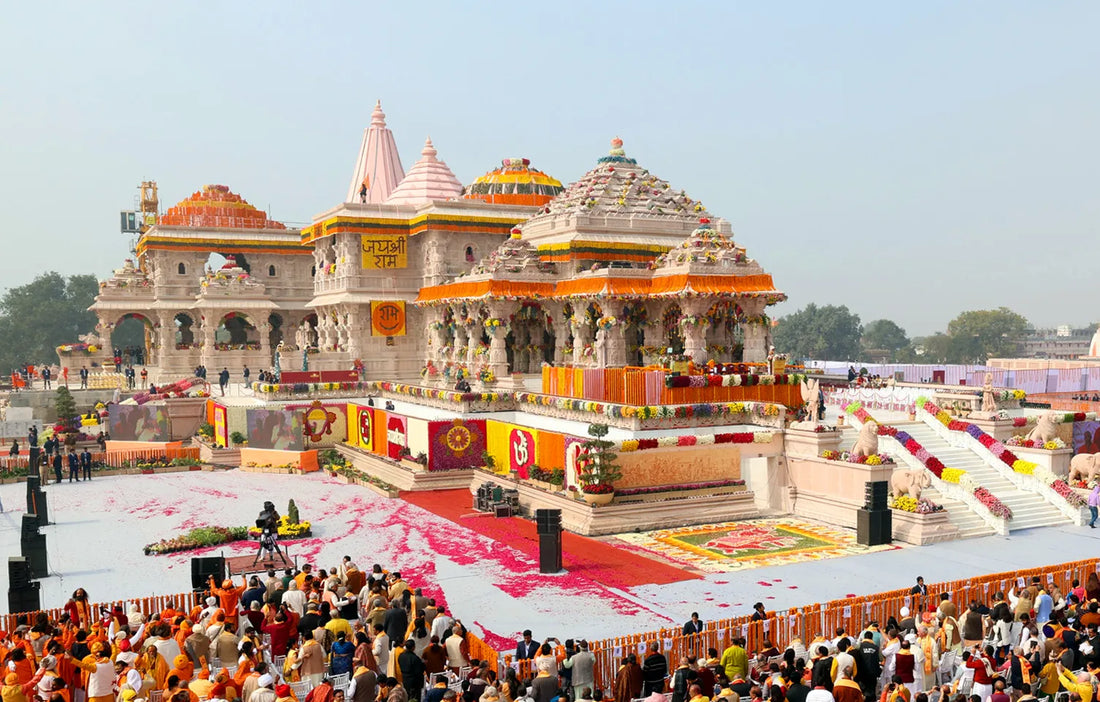
Ram Janmabhoomi Temple in Ayodhya
Introduction to Ram Janmabhoomi Temple
The Ram Janmabhoomi Temple in Ayodhya stands as one of India's most significant religious landmarks, marking the birthplace of Lord Ram, a central figure in Hindu mythology and the protagonist of the epic Ramayana. After decades of historical and legal complexities, the grand temple was consecrated on January 22, 2024, fulfilling the aspirations of millions of devotees across the world.
Built in the traditional Nagara architectural style, this magnificent temple spans approximately 2.7 acres within a larger 70-acre complex. The main structure rises to a height of 161 feet, featuring five mandapas (pavilions): Rang Mandap, Nritya Mandap, Prarthana Mandap, Kirtan Mandap, and the main Garbhagriha (sanctum sanctorum) where the idol of Ram Lalla is enshrined. The temple's pink sandstone facade, intricate carvings, and towering shikhara (spire) create an imposing presence that blends ancient architectural principles with modern construction techniques.
Where is Ram Janmabhoomi Located?
Ram Janmabhoomi is located in the sacred city of Ayodhya, situated on the right bank of the Saryu River in Uttar Pradesh, India. Specifically, the temple complex is positioned in the heart of Ayodhya, approximately 140 kilometers east of Lucknow, the state capital.
The exact coordinates of the Ram Janmabhoomi site are 26.7937° N, 82.1943° E. This location has been revered for centuries as the birthplace of Lord Ram, the seventh avatar of Lord Vishnu according to Hindu belief. The newly constructed temple stands on this precise spot, transforming what was once a disputed area into a magnificent center of worship and cultural significance.
Why is Ram Janmabhoomi Important?
The significance of Ram Janmabhoomi lies in its deep spiritual and historical roots. This is the birthplace of Lord Ram, who symbolizes righteousness (Dharma) and is the central figure of the epic Ramayana. The temple is not just a place of worship but also a symbol of faith, unity, and resilience.
The History Behind Ram Janmabhoomi
The history of Ram Janmabhoomi spans centuries. It has been the center of devotion, conflict, and now peace. After a long legal and spiritual struggle, the construction of the Ram Mandir began in 2020 following the Supreme Court verdict. The grand temple is being built with ancient Indian architecture, showcasing the spirit and culture of Sanatan Dharma.
If you want to bring the aura of Ram Mandir into your home, check out these beautiful miniature Ram Mandir models:
🔗 Shree Ram Temple 3D Model
🔗 Shree Ram Temple
🔗 Jai Shree Ram Temple
How to Reach Ram Mandir in Ayodhya
- By Air: The nearest airport is Maharishi Valmiki International Airport, Ayodhya, with direct flights from major cities.
- By Train: Ayodhya and Ayodhya Cantt railway stations are well connected.
- By Road: Regular buses and taxis are available from Lucknow, Varanasi, and Gorakhpur.
Best Time to Visit Ram Janmabhoomi
The best time to visit is during October to March, when the weather is pleasant. Festivals like Ram Navami, Diwali, and Makar Sankranti bring special celebrations and spiritual vibes to the temple.

Darshan Timings and Entry Details
- Opening Time: 6:00 AM
- Aarti & Darshan: Morning, Noon, and Evening slots
- Entry Fee: Free (Special Darshan/Queue Bypass available at nominal charges)
- Always check the official temple site or local sources for latest timings before planning your visit.
Nearby Temples and Places to Explore
Ayodhya is dotted with many sacred sites:
- Hanuman Garhi – A temple dedicated to Lord Hanuman.
- Kanak Bhawan – Believed to be gifted to Sita by Kaikeyi.
- Saryu Ghat – Ideal for a peaceful dip and aarti by the river.
-
Nageshwarnath Temple – An ancient Shiva temple with mythological roots.
Tips for First-Time Visitors
- Dress modestly and respectfully.
- Carry a water bottle and wear comfortable footwear.
- Try visiting during early morning hours for a peaceful darshan.
- Photography might be restricted in some areas—always check signs.
Don't forget to explore local sweets and prasad like Ayodhya peda.
A Journey of Faith and Devotion
Visiting Ram Janmabhoomi Temple in Ayodhya is more than just a pilgrimage - it's an experience of divine connection and cultural pride. The temple stands as a symbol of truth, devotion, and resilience. Whether you visit in person or bring home a miniature Ram Mandir, the blessings of Shri Ram will always guide your path. Jai Shree Ram!
